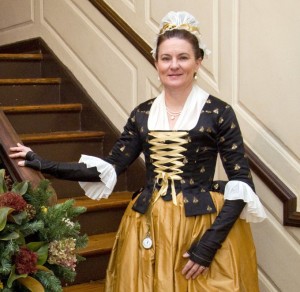 Relevant History welcomes Kimberly Walters, a living historian, author, and owner of K. Walters at the Sign of the Gray Horse, which offers historically-inspired jewelry. Kim is a proud horse mom first and foremost. She is a member of the National Society Daughters of the American Revolution, currently of the Fincastle Chapter of Louisville, Kentucky, as well as the Association of Living History, Farm, and Agricultural Museums. She also serves her country as a Federal employee. Sales from A Book of Cookery by a Lady help support her rescued Colonial Williamsburg horse. To learn more, check out her web site.
Relevant History welcomes Kimberly Walters, a living historian, author, and owner of K. Walters at the Sign of the Gray Horse, which offers historically-inspired jewelry. Kim is a proud horse mom first and foremost. She is a member of the National Society Daughters of the American Revolution, currently of the Fincastle Chapter of Louisville, Kentucky, as well as the Association of Living History, Farm, and Agricultural Museums. She also serves her country as a Federal employee. Sales from A Book of Cookery by a Lady help support her rescued Colonial Williamsburg horse. To learn more, check out her web site.
*****
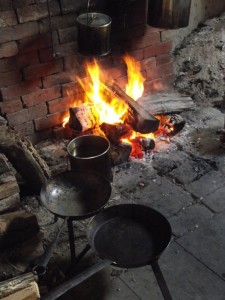 When I started participating in living history events, a friend recommended that I look into hearth cooking to give me a purpose and something to do. I was skeptical, but I am not one to sit around and do nothing, no matter where I am. Wasn’t that hot and sweaty work? With five rescue horses, I’m not a lightweight, so I am used to working hard, but this was a different kind of work. Nevertheless, I was not prepared for what I was getting myself into! I did start my research with passion and immersed myself into the subject. What’s not better to like than food?
When I started participating in living history events, a friend recommended that I look into hearth cooking to give me a purpose and something to do. I was skeptical, but I am not one to sit around and do nothing, no matter where I am. Wasn’t that hot and sweaty work? With five rescue horses, I’m not a lightweight, so I am used to working hard, but this was a different kind of work. Nevertheless, I was not prepared for what I was getting myself into! I did start my research with passion and immersed myself into the subject. What’s not better to like than food?
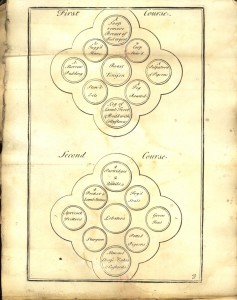 After I studied period cookery books and actually cooked over a fire, I compiled appropriate recipes (also known as receipts in the time period). I was so enamored with how they did things in the kitchen and in dining, I couldn’t stop. My original concept was to find the most common things of the time period that would assist me with interpreting this part of history to the public without a bunch of notes tucked away in my pocket (or having to remember it). It was all really meant for me. That sounds kind of selfish but it is true! However, many of us that do research cherish the little bits of information that we find that are not well known and like to keep them close to us like the “Gollum” did of the “One Ring” of the The Hobbit by J.R.R. Tolkien. They are precious!
After I studied period cookery books and actually cooked over a fire, I compiled appropriate recipes (also known as receipts in the time period). I was so enamored with how they did things in the kitchen and in dining, I couldn’t stop. My original concept was to find the most common things of the time period that would assist me with interpreting this part of history to the public without a bunch of notes tucked away in my pocket (or having to remember it). It was all really meant for me. That sounds kind of selfish but it is true! However, many of us that do research cherish the little bits of information that we find that are not well known and like to keep them close to us like the “Gollum” did of the “One Ring” of the The Hobbit by J.R.R. Tolkien. They are precious!
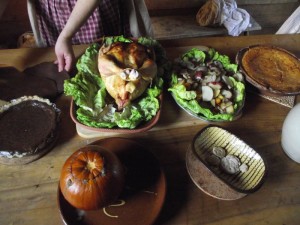 Five years later, I decided to publish my findings as A Book of Cookery by a Lady. I did so on what would have been my Mom’s birthday as a tribute to her. I was also enamored with an article written about Mrs. Elizabeth Thompson, George Washington’s housekeeper during the war years, by Ms. Nancy K. Loane. Mrs. Thompson’s service is not really well known, yet she deserves to be remembered for running the great general’s household and feeding his staff. I have compiled a history on her as a memorial of her service. It is a highlight of the book.
Five years later, I decided to publish my findings as A Book of Cookery by a Lady. I did so on what would have been my Mom’s birthday as a tribute to her. I was also enamored with an article written about Mrs. Elizabeth Thompson, George Washington’s housekeeper during the war years, by Ms. Nancy K. Loane. Mrs. Thompson’s service is not really well known, yet she deserves to be remembered for running the great general’s household and feeding his staff. I have compiled a history on her as a memorial of her service. It is a highlight of the book.
A lot of chapters are interesting from a historical viewpoint—but also very practical for today. This includes items in season, cooking terms, measurements, receipts, how to carve meats, setting a table for one to thirty dishes, and even how to choose your produce at the market.
Kitchen cleanliness and safety in the 18th century
One of the other areas that I think is highly important and underrepresented is cleanliness and safety in the 18th-century kitchen. What was really considered, done, and written down? I’m always asked if I am going to use bleach, soap, and sanitizer when cooking. No. I use 18th-century methods, and they work. General observations for cooks and what they needed to do to ensure they did not poison or make anyone sick were also noted in my book. This focused on utensils and equipment.
The types of metals that the equipment was made from and how they were cleaned was very important. If a cook wanted to poison someone, they could do so by using a certain type of pot that had verdigris on it and serving it right up! Cooks did not know that some of the metals were deadly that they used, but they at least knew that if they were not cleaned correctly, they could be deadly.
I caution the reader not to use an original pot or utensil to cook for demonstration or at home. We may not be able to identify the type of metal it is made from today. By focusing on M. Radcliffe, I highlighted this very issue. Radcliffe talks about lead and its hazards, which is somewhat unique, but by this time well known. Here is an excerpt from her book:
Lead is a metal easily corroded, especially by the warm steams of acids, such as vinegar, cider, lemon-juice, Rhenish wine, &c. and this solution, or salt of lead, is a slow and insidious, though certain poison. The glazing of all our common brown pottery ware is either lead or lead ore; if black, it is a lead ore, with a small proportion of manganese, which is a species of iron ore; if yellow, the glazing is lead ore, and appears yellowish by having some pipe or white clay under it. The colour of the common pottery ware is red, as the vessels are made of the same clay as common bricks. These vessels are so porous, that they are penetrated by all salts, acid or alkaline, and are unfit for retaining any saline substances. They are improper, though too often used, for preserving sour fruits or pickles. The glazing of such vessels is corroded by the vinegar: for, upon evaporating the liquor, a quantity of the salt of lead will be found at the bottom. A sure way of judging whether the vinegar or other acid have dissolved part of the glazing, is by their becoming vapid, or losing their sharpness, and acquiring a sweetish taste by standing in them for some time; in which case the contents must be thrown away as pernicious.
Source:
Radcliffe, M., A Modern System of Domestic Cookery: or, The Housekeeper’s Guide, Arranged on the Most Economical Plan for Private Families. Originally published in 1823, digitized on Google Books Aug 15, 2007.
*****
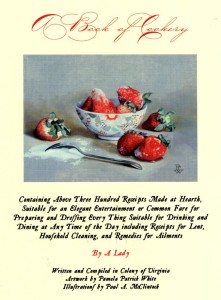 A big thanks to Kimberly Walters. She’ll give away a copy of A Book of Cookery by a Lady to someone who contributes a comment on my blog this week. I’ll choose the winner from among those who comment by Friday at 6 p.m. ET. Delivery is available within the U.S.
A big thanks to Kimberly Walters. She’ll give away a copy of A Book of Cookery by a Lady to someone who contributes a comment on my blog this week. I’ll choose the winner from among those who comment by Friday at 6 p.m. ET. Delivery is available within the U.S.
**********
Did you like what you read? Learn about downloads, discounts, and special offers from Relevant History authors and Suzanne Adair. Subscribe to Suzanne’s free newsletter.





